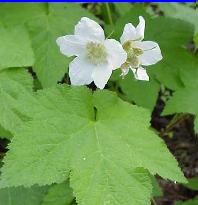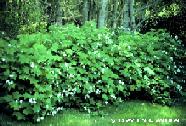

Thimbleberry
Rubus parviflorus Nutt.
An erect shrub 2 to 6 feet tall, with cane-like stems and
shredding, brown bark, and large 5 lobed leaves almost round outline. Leaves
are deciduous, alternate, large (3-8 inches across), and shaped like maple
leaves, with 3-7 palmate lobes and minute, fuzzy hairs on both sides of the
leaf. Flowers are borne singly or in clusters at the end of branches, and are
large (1½ inches across) and white, with petals that look like crumpled tissue
paper. Berries are red, slightly fuzzy, and look and detach like raspberries. These give rise
to juicy, edible red berries. It grows in humid moist places
often in partial shade, near streams and in sheltered woods from valleys to
around 8,000 feet.. Found throughout the Rocky Mountains and in southeastern
Idaho.
Food Use:
The berries are tasty and can be used in a variety of ways.
The Indians at young shoots, either raw or cooked, and made a tea from the
leaves.
Medicine Use:
The leaves are antiemetic, astringent, blood
tonic and stomachic. An infusion is used internally in the treatment of stomach
complaints, diarrhoea and dysentery, anaemia, the spitting up of blood and to
treat vomitting. An infusion has been taken by women when their periods are
unusually long.. A poultice of the dried powdered leaves has been used to treat
wounds and burns. The leaves have been crushed and rubbed over the skin to treat
pimples and blackheads. A poultice of the leaf ashes, mixed with oil, has been
used to treat swellings. The young shoots are alterative and antiscorbutic. The
roots are appetizer, astringent, stomachic and tonic. An infusion has been used
by thin people to help them gain weight. An infusion has also been used in the
treatment of stomach disorders, diarrhea and dysentery. A decoction of the
roots has been taken in the treatment of pimples and blackheads.
Planting
Seed germinates readily, but should be separated from the pulp. Seed not planted
in the fall needs three months cold stratification to break seed dormancy.
Hardwood cuttings grow easily. Small plants salvage well, but are somewhat slow
to establish. Can also be grown from rhizome cuttings or divisions. Grows best
in deep shade and moist soils. Easily grown in a good well-drained loamy soil in
sun or semi-shade. Can be grown in a woodland garden though it is less likely to
fruit well in such a position. Tip layering in July. Plant out in autumn.
